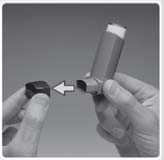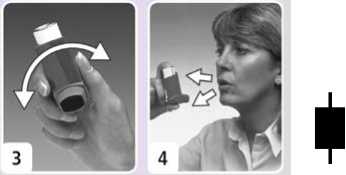Seretide 125 Evohaler 25/125mcg
Out of date information, search another1. What Seretide is and what it is used for
2. Before you use Seretide




PACKAGE LEAFLET: INFORMATION FOR THE USER SERETIDE® 125 EVOHALER®
SERETIDE® 250 EVOHALER®
(salmeterol xinafoate / fluticasone propionate)
This product is available in either of the above names and strengths but will be referred to as Seretide throughout the remainder of this leaflet.
This product is available in multiple strengths and all strengths will be referred to throughout this leaflet.
Read all of this leaflet carefully before you start taking this medicine.
• Keep this leaflet. You may need to read it again.
• If you have any further questions, ask your doctor or pharmacist.
• This medicine has been prescribed for you. Do not pass it on to others. It may harm them, even if their symptoms are the same as yours.
• If any of the side effects gets serious, or if you notice any side effects not listed in this leaflet, please tell your doctor or pharmacist.
In this leaflet:
1. What Seretide is and what it is used for
2. Before you use Seretide
3. How to use Seretide
4. Possible side effects
5. How to store Seretide
6. Further information
Seretide contains two medicines, salmeterol and fluticasone propionate:
• Salmeterol is a long-acting bronchodilator. Bronchodilators help the airways in the lungs to stay open. This makes it easier for air to get in and out. The effects last for at least 12 hours.
• Fluticasone propionate is a corticosteroid which reduces swelling and irritation in the lungs.
The doctor has prescribed this medicine to help prevent breathing problems such as asthma.
You must use Seretide every day as directed by your doctor. This will make sure that it works properly in controlling your asthma.
Seretide helps to stop breathlessness and wheeziness coming on. It does not work once you are breathless or wheezy. If that happens you need to use a fast acting ‘reliever' medication, such as salbutamol.
Do not take Seretide if:
You are allergic (hypersensitive) to salmeterol, fluticasone propionate or to the other ingredient norflurane (HFA 134a).
Take special care with Seretide
Your doctor will supervise your treatment more closely if you have medical conditions such as:
• heart disease, including an irregular or fast heartbeat
• overactive thyroid gland
• high blood pressure
• diabetes mellitus (Seretide may increase your blood sugar)
• low potassium in your blood
• Tuberculosis (TB) now, or in the past.
If you have ever had any of these conditions, tell your doctor before you use Seretide.
Taking other medicines
Please tell your doctor or pharmacist if you are taking or have recently taken any other medicines. This includes medicines for asthma or any medicines obtained without a prescription. This is because Seretide may not be suitable to be taken with some other medicines.
Tell your doctor if you are taking the following medicines, before starting to use Seretide:
• Beta-blockers (such as atenolol, propranolol and sotalol). Beta-blockers are mostly used for high blood pressure or other heart conditions.
• Antiviral and antifungal medicines (such as ritonavir, ketoconazole and itraconazole). Some of these medicines may increase the amount of fluticasone propionate or salmeterol in your body. This can increase your risk of experiencing side effects with Seretide, including irregular heart beats, or may make side effects worse.
• Corticosteroids (by mouth or by injection). If you have had these medicines recently, this might increase the risk of this medicine affecting your adrenal gland.
Pregnancy and breast-feeding
If you are pregnant, planning to get pregnant, or breast-feeding, talk to your doctor before taking Seretide. Your doctor will assess whether you can take Seretide during this time.
Driving and using machines
Seretide is not likely to affect your ability to drive or use machines.
3. How to use Seretide
• Use your Seretide every day, until your doctor advises you to stop.
• Always use Seretide exactly as your doctor has told you. Don't exceed the recommended dose. Check with your doctor or pharmacist if you're not sure.
Adults and adolescents aged 12 years and over
• Seretide 50 Evohaler - 2 puffs twice a day
• Seretide 125 Evohaler - 2 puffs twice a day
• Seretide 250 Evohaler - 2 puffs twice a day
Children 4 to 12 years of age
• Seretide 50 Evohaler - 2 puffs twice a day
• Seretide is not recommended for use in children below 4 years of age.
Your symptoms may become well controlled using Seretide twice a day. If so, your doctor may decide to reduce your dose to once daily. The dose may change to:
• once at night - if you have night-time symptoms
• once in the morning - if you have daytime symptoms.
It is very important to follow your doctor's instructions on how many inhalations to take and how often to take your medicine.
If you are using Seretide for asthma, your doctor will want to regularly check your symptoms.
If your asthma or breathing gets worse, tell your doctor straight away. You may find that you feel more wheezy, your chest feels tight more often or you may need to use more of your fast acting 'reliever' medicine. If any of these happen, you should continue to take Seretide but do not increase the number of puffs you take. Your chest condition may be getting worse and you could become seriously ill. See your doctor as you may need additional treatment.
Instructions for use
• Your doctor, nurse or pharmacist should show you how to use your inhaler. They should check how you use it from time to time. Not using the Seretide Evohaler properly or as prescribed may mean that it will not help your asthma as it should.
• The medicine is contained in a pressurised canister in a plastic casing with a mouthpiece.
• There is a counter on the back of the Evohaler which tells you how many doses are left. Each time you press the canister, a puff of medicine is released and the counter will count down by one.
• Take care not to drop the inhaler as this may cause the counter to count down.
Testing your inhaler
1 When using your inhaler for the first time, test that it is working. Remove the mouthpiece cover by gently squeezing the sides with your thumb and forefinger and pull apart.
2 To make sure that it works, shake it well, point the mouthpiece away from you and press the canister to release a puff into the
air. Repeat these steps, shaking the inhaler before releasing each puff, until the counter reads 120. If you have not used your inhaler for a week or more, release two puffs of medicine into the air.
Using your inhaler
It is important to start to breathe as slowly as possible just before using your inhaler.
1 Stand or sit upright when using your inhaler.
2 Remove the mouthpiece cover (as shown in the first picture). Check inside and outside to make sure that the mouthpiece is clean and free of objects.
3 Shake the inhaler 4 or 5 times to ensure that any loose objects are removed and that the contents of the inhaler are evenly mixed.
4 Hold the inhaler upright with your thumb on the base, below the mouthpiece.
Breathe out as far as is comfortable.
5 Place the mouthpiece in your mouth between your teeth. Close your lips around it.
Do not bite.
6 Breathe in through your mouth. Just after starting to breathe in, press firmly down on the top of the canister to release a puff of medicine. Do this while still breathing in steadily and deeply.
7 Hold your breath, take the inhaler from your mouth and your finger from the top of the inhaler. Continue holding your breath for a few seconds, or as long as is comfortable.
8 Wait about half a minute between taking each puff of medicine and then repeat steps 3 to 7.
9 Afterwards, rinse your mouth with water and spit it out. This may help to stop you getting thrush and being hoarse.
10 After use always replace the mouthpiece cover straight away to keep out dust. When the mouthpiece cover is fitted correctly it will 'click' into position. If it does not 'click' into place, turn the mouthpiece cover the other way round and try again. Do not use too much force.
If you or your child find it difficult to use the Evohaler, either the Volumatic™ or Aerochamber Plus™ spacer device may be used.
Before starting to use a spacer device for the first time or if you need to change your make of spacer device, talk to your doctor, nurse or pharmacist. A special device called a Haleraid™ may also make it easier.
You should get a replacement when the counter shows the number 020. Stop using the inhaler when the counter shows 000 as any puffs left in the device may not be enough to give you a full dose. Never try to alter the numbers on the counter or detach the counter from the metal canister.